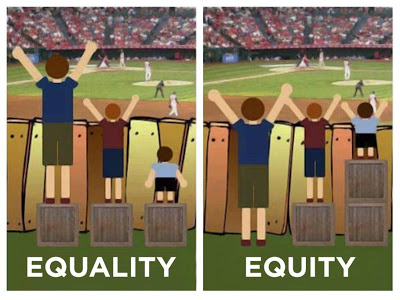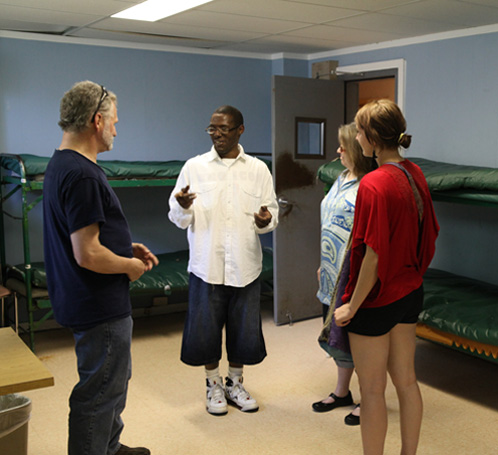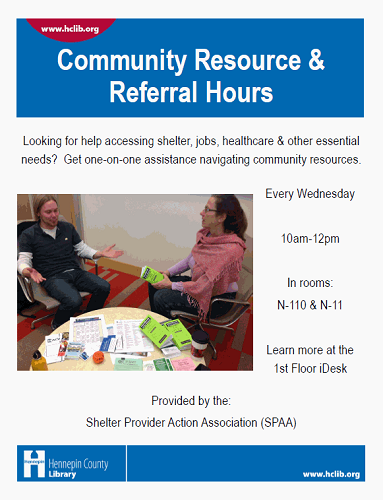Advancing Health Equity through Services to Patrons Experiencing Homelessness
Our guest contributors from Hennepin County Library participated in the Blue Cross and Blue Shield of Minnesota Foundation's Public Libraries for Health program. Their experience supported the development of a free toolkit for public library staff to utilize in advancing health equity. Access WebJunction's Health Happens in Libraries resources for even more information on supporting community health through library services!
 "In order to maximize opportunities for access experienced by certain groups, a good society commits resources in order to level the playing field…if access policies concentrate solely on the objective of equality without reference to equity, their achievements will be flawed because those struggling to catch up will fall farther behind."
"In order to maximize opportunities for access experienced by certain groups, a good society commits resources in order to level the playing field…if access policies concentrate solely on the objective of equality without reference to equity, their achievements will be flawed because those struggling to catch up will fall farther behind."
Hennepin County Library is a large public library system, serving a diverse community through its 41 branch libraries spanning 611 square miles of urban and suburban Hennepin County. HCL also provides outreach services to more than 70 senior residences, 1000+ homebound residents and to both the adult and juvenile correctional facilities. It is among our topmost priorities to provide equitable services that reach everyone in our communities who need and want it, including the at least 4,316 adults, youth and families struggling with homelessness in Hennepin County.
In response to the needs of the members of the community struggling with housing insecurity and to carry out our professional obligation to promote "equal access to information," and libraries' "role in enabling poor people to participate fully in a democratic society," we applied for and were awarded a grant from the Blue Cross and Blue Shield of Minnesota Foundation as part of the their Public Libraries for Health Initiative.
This initiative began out of recognition that public libraries are trusted community institutions that can play a key role in advancing health equity and that a person's health is determined by more than their physical health. In fact, research shows that at least 40% of a person's health outcomes are impacted by things like education, employment, income, family and social support, and community safety—all things that are also affected when an individual or family experiences housing insecurity.
With the generous support of the Blue Cross and Blue Shield of Minnesota Foundation, we were able to meet our goals of:
- providing learning opportunities for staff so they can better understand and serve patrons experiencing homelessness;
- partner with community organizations to connect patrons with resources and deliver programming; and
- raise awareness and start a dialogue with staff and the public about the issue of homelessness and how it impacts the community.
We accomplished these goals in several ways that follow.
Learning Opportunities
 Though we were able to provide learning opportunities in a variety of formats, both informal and formal, the training that had the deepest impact with staff was A Day in the Life provided by St. Stephen’s Human Services.
Though we were able to provide learning opportunities in a variety of formats, both informal and formal, the training that had the deepest impact with staff was A Day in the Life provided by St. Stephen’s Human Services.
In A Day in the Life, library staff spent the day with a community educator who shared stories and answered questions about their experience with homelessness. During their time together they walked to and visited shelters, opportunity centers, transitional housing and affordable housing sites where they met people and got a glimpse into the circumstances that some of our patrons face. All in all, the day provided much for staff to reflect upon and apply to their work.
"At the end of the day, I felt much more motivated to be an advocate for the homeless patrons we serve at the library. There are many small actions that we as library workers can take on a day-to-day basis to improve the living experiences of the people we serve."
"The thing I took away that made me feel good about my job is that the library is really a valuable resource for people in dire need."
A Day in the Life is just one way to build empathy and raise awareness among staff. You can contact St. Stephen's Human Services if this is an opportunity you want to provide to staff at your library or if you have a tight budget, consider asking a representative from a local community organization to come and talk to staff at your library.
Connecting to Community Resources
 In addition to implementing resources displays in a number of libraries in the system, we invited representatives from community agencies to meet one-on-one with patrons experiencing housing insecurity to help them connect to resources and services in the community in a program we called Community Resources & Referral Hours.
In addition to implementing resources displays in a number of libraries in the system, we invited representatives from community agencies to meet one-on-one with patrons experiencing housing insecurity to help them connect to resources and services in the community in a program we called Community Resources & Referral Hours.
What makes this program unique and valuable is the setting and the one-on-one attention patrons are afforded. We have observed that when individuals don't know how to navigate the confusing web of resources that might be available to them in their community and don’t know who to turn to for help, they turn to us. One of our volunteers captured the value of the library as a setting for this type of program best when he said: "The library is a public place where everyone spends time whether they have a place to live or not. People can ask for and receive help, and as I see it, still feel a sense of dignity in doing so."
In addition to meeting patrons where they are, this program makes available one-on-one attention and guidance from community experts who answer their questions, listen and provide encouragement and escape from social isolation. As one patron shared: "It was nice just to have somewhere to go where nobody judged you. It was the first time anyone had really spoken to me since I became homeless."
Inviting trusted, local organizations into the library to meet with patrons is just one way to connect patrons to community resources. Displays are another way to make resources accessible in a way that is anonymous yet conveys to patrons that library staff is interested and available to assist.
Innovative Programming
It's tempting to take an approach that only looks at what patrons might be lacking (resources, support systems, transportation, formal education, etc.) and works to fill the gap. Another approach is to design programs that build on the strengths and interests of specific communities experiencing homelessness. We used this approach to deliver a program we call I Dream at the Library.
I Dream at the Library is a program that invited a cohort of ten young people age 20 to 25 who had or were experiencing some level of housing insecurity into the Best Buy Teen Tech Center at Minneapolis Central Library to pursue projects with the guidance and mentorship of staff from a community-based youth education organization called Learning Dreams, as well as Hennepin County Library staff and community artists.
In addition to individual projects, the young adults co-created two public services announcements and planned a showcase event together. They also participated in a modified version of an HCL program called Read To Me where they recorded themselves reading a book and sent the book and recording to a special young person (son/daughter, brother/sister) in their lives whom they had been separated from due to their housing situation. In the fall of 2015 we worked with our second cohort and invited previous participants to return to serve as mentors.
Advocacy & Awareness
Art exhibits, theatrical productions and film screenings were a few of the ways that we leveraged the library's potential as a social mixing pot and public forum to raise awareness and start a dialogue about how issues like homelessness affect the communities we live in.
Though the grant period has ended, the work is far from over. We have continued our mission-driven work to provide equitable services to all members of the community, including those experiencing homelessness by forming a system-wide work group dedicated to that task. These staff will lead continuing resource development and education, partnering with organizations in the community, and setting a course for the future based on the commitment statement which they collaboratively wrote:
Hennepin County Library is dedicated to serving patrons experiencing homelessness by providing equitable and inclusive service with compassion and understanding.
We are committed to educating staff to be responsive to patron needs, sharing targeted resources and engaging the whole community to raise awareness of issues surrounding poverty and homelessness.
Through our efforts we have learned that homelessness affects the health of individuals and families in all kinds of communities whether they are urban, suburban or rural. We also know that as trusted public institutions, we can make a difference in the effort to make our communities more healthy and equitable.
Image credits (from top): OutFront Minnesota, St. Stephen’s Human Services, Hennepin County Library
